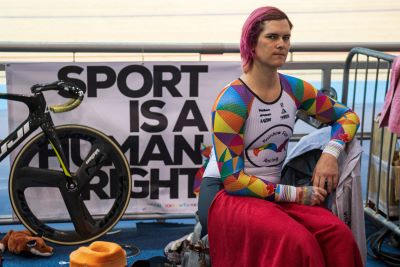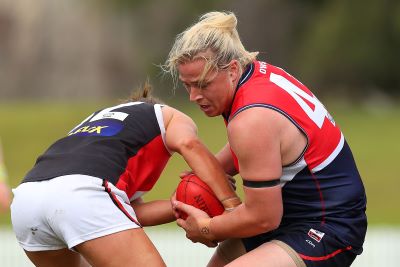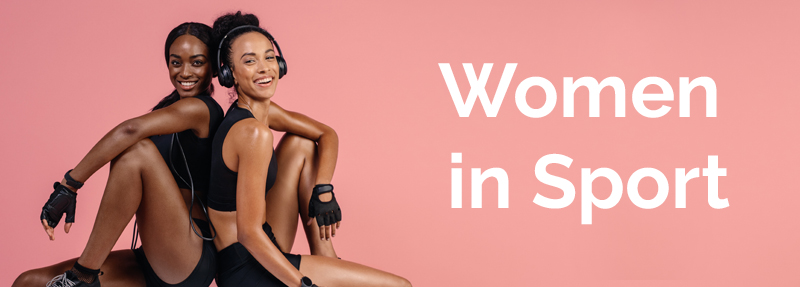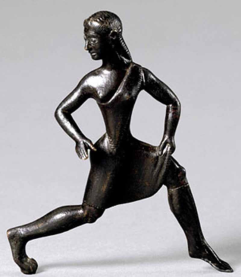Rachel McKinnon
 Rachel McKinnon
In October 2019, Canadian cyclist Rachel McKinnon (now known as Veronica Ivy) won the Women’s Master’s 200-metre cycle sprint at the Manchester Velodrome. ‘Good for Rachel’, we might say, ‘she must have trained hard to achieve such success’. However, Rachel was born Rhys McKinnon, a biological male who decided to transition to female in her 20s. Standing at 6 foot tall, and weighing more than 14 stones, she towers over her opponents. Many cycling competitors and former top sportswomen, including tennis champion Martina Navratilova, Olympic gold medallist Kelly Holmes, and Olympic silver medallist Sharron Davies, have labelled this as unfair as Ivy has benefited from being born male, experiencing male puberty, thus gaining physical advantages over women born female, natal women.
Rachel McKinnon
In October 2019, Canadian cyclist Rachel McKinnon (now known as Veronica Ivy) won the Women’s Master’s 200-metre cycle sprint at the Manchester Velodrome. ‘Good for Rachel’, we might say, ‘she must have trained hard to achieve such success’. However, Rachel was born Rhys McKinnon, a biological male who decided to transition to female in her 20s. Standing at 6 foot tall, and weighing more than 14 stones, she towers over her opponents. Many cycling competitors and former top sportswomen, including tennis champion Martina Navratilova, Olympic gold medallist Kelly Holmes, and Olympic silver medallist Sharron Davies, have labelled this as unfair as Ivy has benefited from being born male, experiencing male puberty, thus gaining physical advantages over women born female, natal women.
Hannah Mouncey
 Hannah Mouncey
Hannah Mouncey is an Australian handball player who started life as Callum Mouncey, a male. She stands at 6 foot 2 inches tall, and weighs nearly 16 stone. As Callum, he played on the Australian men’s handball team. It is useful to see Hannah in action, competing in a sport where collisions occur, to see that it is actually quite frightening, as much smaller opponents are crashed into and dominated physically. Recently Hannah has withdrawn from the women's handball team. She has been deemed a danger to other players due to her size, but also her teammates have objected to having to change and shower with someone with a male body. Hannah thinks this is unfair.
Hannah Mouncey
Hannah Mouncey is an Australian handball player who started life as Callum Mouncey, a male. She stands at 6 foot 2 inches tall, and weighs nearly 16 stone. As Callum, he played on the Australian men’s handball team. It is useful to see Hannah in action, competing in a sport where collisions occur, to see that it is actually quite frightening, as much smaller opponents are crashed into and dominated physically. Recently Hannah has withdrawn from the women's handball team. She has been deemed a danger to other players due to her size, but also her teammates have objected to having to change and shower with someone with a male body. Hannah thinks this is unfair.
Kelly Morgan
Then there is Kelly Morgan, a Welsh rugby player born Nicholas Gareth Morgan. After sustaining an injury playing men’s rugby, Nicholas decided to transition to a woman, and to play rugby again, but this time for a women’s team. At 6 foot tall and with a robust athletic build she is a force to be reckoned with. Her coach claims that she will be really good as long as she doesn’t injure too many of her teammates in training. The risks Kelly, and other male to female rugby players, pose to natal females have been recognised by former England rugby star Brian Moore, and by referees who are considering quitting because they cannot guarantee the safety of natal female players. World Rugby has recently reviewed the situation, but to date has not yet published its report.
Sport and Sex
The examples above are but a few of what has become a growing phenomenon: the participation of male bodied transgender women (TW) in women’s sports. The issue which needs to be addressed is whether this is fair to natal born women.
Competitive sport has traditionally been segregated by sex (not gender, more of that later). The reason for this is that humans, along with most mammalian species, are sexually dimorphic. This means that, as well as playing a different role in reproduction, male and female bodies differ in many respects. Males, on average:
- are taller
- are stronger
- are more muscular
- have broader shoulders and longer limbs (set at different angles to female limbs)
- have larger hearts and lungs and have more circulating red blood cells.
All of these differences contribute to a ‘performance gap’ where it can be seen that males outperform females by between 10 and 30% depending on the sport in question. An example would be US sprinter Tori Bowie, 100 metre world champion, and Olympic medallist. It is estimated that her best times in 2017 would have been beaten 15,000 times by men and boys. It has also been estimated that world tennis champion Serena Williams would be beaten by most male players currently ranked internationally in spite of being a superbly fit and athletic woman.
Let's talk about sex
Sex is decided at the moment of conception, or shortly thereafter, and is dependent on the chromosomes of the embryo: XY for males, XX for females (there are some variations on this it is acknowledged, but it is beyond the scope to explore here). Dimorphic development is inevitable from then on. There are few differences between boys and girls physically until adolescence. In females the hormone oestrogen is released and, in boys, testosterone. It is testosterone which drives the above noted differences in male physiology, and therefore sporting performance. For a review of the many sex differences affecting sports performance see Handelsman et al. 2018.
The issue then is that if the above male advantages have led to sex segregated competition, is it fair to include TWs in the women’s category? The points to be addressed are complex, and include how a TW is defined, and how sporting access is decided.
Who is a transgender woman (TW)?
The issue of who is a TW is not simple, and depends on where on the globe you live. A discussion of the variations of this is too complicated to go into is , however in the UK a transgender person is anyone who claims that they are. To effect a change on one’s birth certificate, however, a person has to:
- apply to a panel for a Gender Recognition Certificate (GRC)
- provide supporting evidence of gender dysphoria (usually from a psychologist and their regular GP)
- prove they have been living in their chosen gender for 2 years
- verify that they intend to do so for the rest of their lives.
 Note that according to UK law there is no need of any form of medical intervention, surgical or hormonal. Many transgender individuals feel that this process is cumbersome and invasive of their privacy and it is currently under review, with one proposal being a revised Gender Recognition Act which hinges simply on self-identification. This is already out for consultation in Scotland. However, on 22 April 2020 Liz Truss MP, Minister for Women and Equalities, giving evidence to the Women and Equalities Select Committee, stated that the protection of single-sex spaces was extremely important.
Note that according to UK law there is no need of any form of medical intervention, surgical or hormonal. Many transgender individuals feel that this process is cumbersome and invasive of their privacy and it is currently under review, with one proposal being a revised Gender Recognition Act which hinges simply on self-identification. This is already out for consultation in Scotland. However, on 22 April 2020 Liz Truss MP, Minister for Women and Equalities, giving evidence to the Women and Equalities Select Committee, stated that the protection of single-sex spaces was extremely important.
The implications of this for sportswomen (and other female-only spaces) could obviously be immense. If single-sex spaces are not protected a man may only need to identify as a woman to gain access to all types of women-only spaces and events. However, sporting organisations have their own criteria. For a review of these sport policies see a 2017 article on sport and transgender people. These are all mainly dependent on current (not past) testosterone levels (some also require gender confirming surgery). The International Olympic Committee (IOC) stated in 2015 that TWs must have declared their gender as female, and have testosterone levels below 10 nanomoles per litre (nmol/L) of blood for at least the last 12 months. It is worth noting that average testosterone levels for healthy males range from 7 to 30 nmol/L, and for women .06 to 1.67 nmol/L.
Therefore, if we are assuming that testosterone is the driver of enhanced physical performance then, for the IOC, it’s acceptable for TWs to have circulating testosterone levels much higher than those of natal women. It is worth noting that the make-up of this committee was overwhelmingly male and it is not known to what extent the feelings of natal female athletes were considered. Other organisations, such as cycling and rugby, have different criteria, but generally depend on current testosterone levels. All of these reductions in testosterone for TWs are achieved by chemical means. Individuals are given testosterone blockers to reduce testosterone levels, and oestrogen which is a feminising hormone.
Can natal born females and transgender women compete fairly and on equal terms?
Some studies have shown that cross sex hormone administration in TWs causes them to lose 2.4kg of lean body mass during 12 months of treatment. It has also been shown that transwomen experience a 9% reduction in thigh muscle cross-section, but no reduction in bone geometry or density during 2 years of cross-sex hormone treatment. Recently, in 2019, the influence of female sex hormone therapy on cardiac output parameters of a biological male undergoing male-to-female gender reassignment has been investigated. It was found that cardiac function was compromised throughout the first 12 months of treatment. However, this study was based on the responses of one athlete. There is little in the way of solid evidence to show whether these changes actually affect sports’ relevant parameters.
A first study comparing MF transgender non-elite runners, pre- and post-transition, was published in 2016 by Joanna Harper, herself transgender. Joanna concluded that hormone therapy resulted in the transgender females continuing to run within the norms of their age/gender category. Therefore, being born male conferred no lasting advantage. However, this was on a sample of only 8 runners, and was not controlled in a way that would be considered acceptable.
TW’s muscle volume decreased after 12 months of cross sex hormone treatment, but in general, strength was maintained, or slightly increased.A 2019 study from the world-renowned Karolinska Institute in Sweden is informative and provides a different point of view. Investigators there wanted to know whether the changes in muscle volume were reflected in changes in strength. The findings were that TW’s muscle volume decreased after 12 months of cross sex hormone treatment, but in general, strength was maintained, or slightly increased. It would seem therefore that, on admittedly little evidence, cross sex hormones do not negate male sporting advantage for TWs in terms of leg strength. As this phenomenon is relatively new, it remains to be seen what further research will reveal.
A relevant, but rather different, angle on the issue comes from a 2019 study on ageing male endurance athletes. The authors conducted an intensive 18-week endurance programme with older male runners, which resulted in an acute reduction in resting testosterone levels. However, exercise performance was not affected. This indicates that the reliance on circulating testosterone may not be a reliable marker for sports performance.
Whether cross sex hormone administration can ever negate the advantages gained by a male individual who goes through male puberty is crucial to the fairness debate. Stature is not reduced, limb structure remains the same, and heart and lung size remain the same. There is also evidence of epigenetic muscle changes changes which facilitate muscle growth. Basically, this means that trained muscle which then becomes detrained retains the same number of myonuclei (muscle cells) which then facilitate a re-training response. Whether hormonal intervention affects this is not yet known.
Transgender athlete Rachel McKinnon (now Veronica Ivy) is adamant that she has won her medals fairly and that transgender women have every right to compete in women’s sports. She notes that all women vary in size and strength anyway and to single TWs out is discriminatory and transphobic. It has also been noted that ‘genetic variability in some female athletes may on occasion produce an “uber-athlete” who could dominate in women’s sports’, so that a transgender athlete might just be a variant of that category. McKinnon (Ivy) further notes that the Olympic Charter states that sport is a human right and she is not to be denied, and that sport should be inclusive. It has also been argued that current restrictions on TW participation in women’s sports are not based on any credible evidence and that the majority of competitive sports policies are discriminatory. However, this was not based on any biological or physiological data.
How can we be inclusive to all?
It is not the purpose here to argue against inclusion, but to examine what would be inclusive of TW, but which does not become unfair and therefore exclusive of natal females.
A look at terminology here is instructive. According to the Office for National Statistics (ONS) in 2019, the UK government defines sex as:
‘referring to the biological aspects of an individual as determined by their anatomy, which is produced by their chromosomes, hormones and their interactions
Generally male or female
Something that is assigned at birth’
On the other hand, gender is:
‘a social construction relating to behaviours and attributes based on labels of masculinity and femininity, gender identity is a personal, internal perception of oneself and so the gender category someone identifies with may not match the sex they were assigned at birth’.

Sex v gender
The important inference to be drawn here is that sex and gender are not the same thing, although many now seem to think they are. Sex is physical, defined by immutable chromosomal makeup. Gender is an ‘internal perception’.
The Equalities Act 2010 in the UK defines 9 protected characteristics, of which sex (not gender) is one.It would appear therefore that rather than sport being sex segregated, it is becoming gender segregated.
The Equalities Act 2010 in the UK defines 9 protected characteristics, of which sex (not gender) is one. The act permits separate facilities for females and males. The issue at hand is now whether a female is defined by sex or by gender.
As mentioned previously, McKinnon/Ivy has vigorously defended her position (and medal count), stating unequivocally that ‘transwomen are women’, mainly because she has a piece of paper saying so. The British sports sociologist Ellis Cashmore has also spoken in defence of TW sportswomen saying that ‘sport has to adapt to accept transgender athletes’, as this is the way society is going. It is not anticipated that Cashmore has any female friends or relatives who are set to be denied medals because of this stance.
What strategy would be fair to all?
In the USA, many high school and college athletes have seen transgender sportswomen winning in female competitions. This has led to protests from many natal female athletes and several states filing to limit female sports to natal born females (e.g. in Arizona). In Canada, Dr Linda Blade, an athletics coach and human biologist, has spoken about this issue, arguing that this policy is exclusive to natal women and girls and limits their opportunities.
The organisation Fairplayforwomen asserts that sport should remain sex segregated to be fair to natal sportswomen. Gender should not be an issue. If this stance is adopted, and we subscribe to the ‘sport is a human right’ view of the IOC, then the question becomes: how do we accommodate transgender women? Clearly there is no wish on anyone’s part to exclude any human being from sports participation.
And finally...
In conclusion, there are clearly choices to be made:
- TWs are classed as female and equal to natal born women for the purposes of sports performance. This stance is unpopular with many natal female sportswomen, and will be a disadvantage to them because of the male pubertal physical changes outlined above.
- Another option is that the female category be open to natal females only, and that the male category should be open to all, or that athletes compete on the basis of their birth sex. This may cause problems of female to male athletes as they may run foul of doping guidelines due to administration of testosterone if they compete in the female category.
- A third option is to have a separate transgender category. This is unlikely to be feasible in the near future due to the small numbers of eligible participants. However, it is interesting to note that in the United States an all transgender ice hockey team has formed and played their first match in 2019.
It is clear that there are no easy options here.
So far the issue of female to male transgender sportsmen has not been mentioned. This is because there are (to our knowledge) very few of these, and none are dominating male competition to the extent that some TW sportswomen are succeeding in women’s sports. Conclusions might be drawn from this.
 Explore more articles in this collection by clicking on the banner above
Explore more articles in this collection by clicking on the banner above







Rate and Review
Rate this article
Review this article
Log into OpenLearn to leave reviews and join in the conversation.
Article reviews